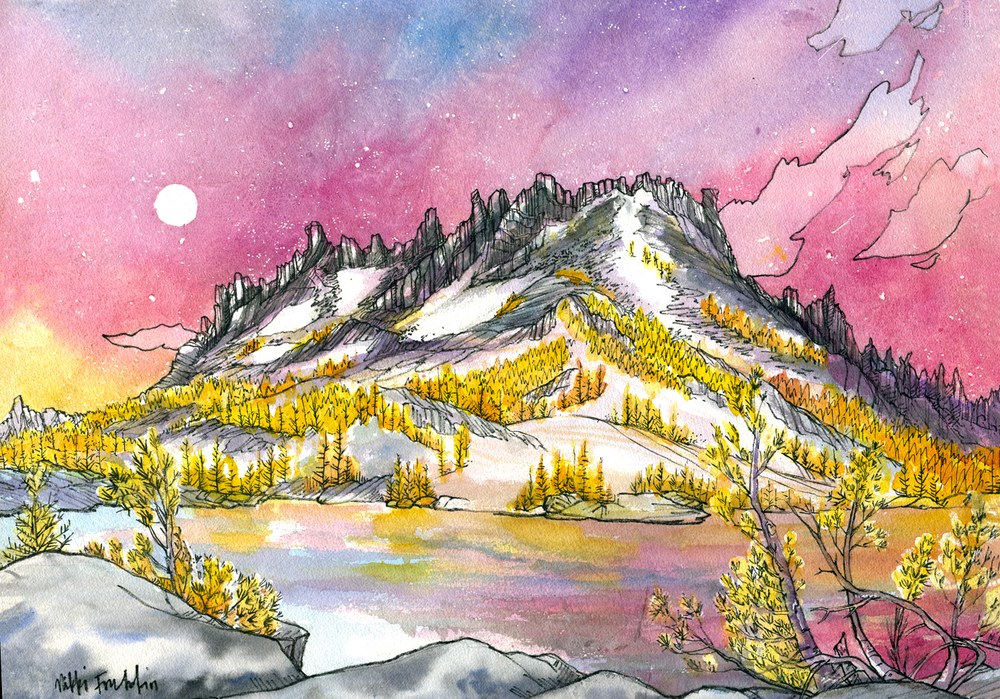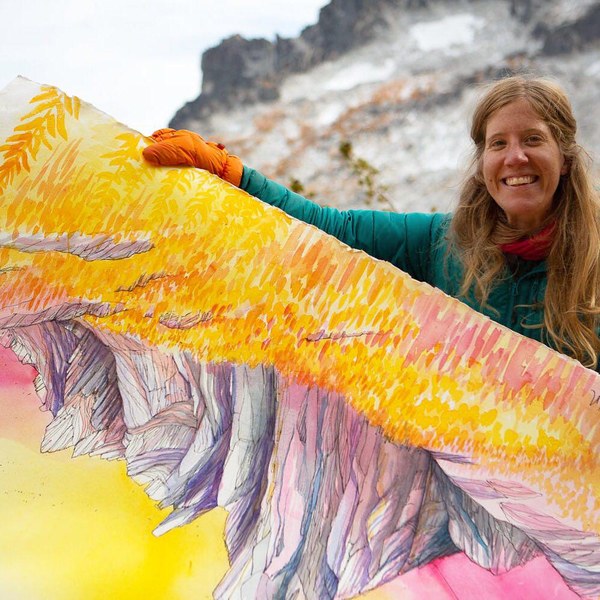
Nikki Frumkin is a local alpinist and the artist behind Drawn to High Places. Through her whimsical watercolor and ink paintings, Nikki creates magical and inspiring portrayals of our local outdoor playgrounds. I have long admired her works for the way they transport the viewer to our beloved northwest peaks, and remind us why these places capture our collective imaginations.
Nikki is also a Mountaineers member and supporter of our mission, having donated an original piece to our annual Gala for several years. As a budding alpinist and watercolorist myself, I was excited to interview Nikki about her art, inspirations, and techniques. Nikki’s humble and playful attitude about painting was inspiring, and I hope to incorporate that lightness into my own paintings the next time I head to the hills.
What's the story of your outdoor experience?
My mom has a huge appreciation for nature and is passionate about animal rescue. Growing up we had a million dogs that needed to be walked, so we spent a lot of time in the woods near our house.
I moved to Seattle spontaneously about seven years ago, after ending a cross-country road trip here. When I arrived, I looked at Mount Rainier, the North Cascades, and the Olympics, and thought, “I'm never going back!” I've been here ever since. I started getting into mountaineering right away. There was a lot of learning those first two years! At first, even just hiking was so overwhelming.
Friends, mentors, and people from the Pacific Northwest Outdoor Women's (PNWOW) group on Facebook took me in and taught me new skills. There is no way I'd be able to do what I'm doing now if it hadn't been for all those people who took me under their wing. Because of that, being a mentor has become important to me as a way of giving back to people just getting started.
When did you start incorporating art into your outings?
I think it was five or six years ago. Shawn, my partner, and I did my first snow camping trip at Artist's Point on Mount Baker on a super socked in weekend. Shawn suggested I bring my watercolors and it was a great idea! I don't think I used them that trip, but I did make a little sketch of Shuksan. It was such a fun way to capture all those huge, overwhelming feelings of sleeping in the cold for the first time and seeing the beautiful sunrise.
From then on, every trip I brought the watercolors with me. That first one was in a little sketchbook, but I soon switched to bits of paper that were lighter. For a while I just brought palm-sized pieces of paper, and now I use paper up to the size of a twin bed that I roll up and strap to my backpack. My pieces keep getting bigger and bigger!
What do you find special about using watercolors and ink to depict natural landscapes?
From a practical perspective, watercolors are super portable, easy to use, and dry quickly. The simpler the medium is to clean up, the better. What makes watercolors truly magical is their translucency, where you can layer them and see the colors and the light that's underneath. They do a beautiful job of capturing light, movement, and weather. When I think about being in the mountains, I think about feeling the wind and the weather changing around me and spending a lot of time looking towards the sky and thinking about what's coming in next. Putting that on paper with watercolors is easy because they have movement to them.
My grandmother is a watercolor artist and she gave me my first set of watercolors when I moved here. That was a really special way to get into it. Before I moved to Seattle, I was an oil painter and was doing huge landscapes of the Hudson Valley. I definitely came to Seattle with a sense of how to put paint on paper, but when I started using watercolors, it was a totally different story. They're much more chaotic, which I like.
 A bed-sized painting of Prusik Peak, painted on a 5-day backpacking trip in the Alpine Lakes Wilderness.
A bed-sized painting of Prusik Peak, painted on a 5-day backpacking trip in the Alpine Lakes Wilderness.
How has art enriched your outdoor experience?
It takes time to paint. Even when you're quick, you have to sit and really look. You get to experience the landscape over time in a way that you might not if you were just passing through. You see things you might have missed. Painting is an extra little reason to stay for sunrise or sunset or be awake at night to see the stars. Painting highlights the relationship between me and the landscape, because I really see and feel what’s around me.
Additionally, I've made so many friends with people who have enjoyed the same places I’ve painted. It’s cool to inspire people to paint, and sometimes we go out and paint together.
It’s also special when someone sees one of my paintings and realizes, “I know that feeling too.” That's been one of my favorite things about painting in Washington, connecting with people who see themselves in my paintings. One of my favorite messages that I’ve received on my website came from someone who bought a print of my painting of Mount Rainier and a little red tent with a couple inside. She told me she saw this painting and fell in love because it was how her child was conceived, in a tent outside of Mount Rainier. It made me so happy!
What are some ways folks can begin incorporating art into their outings?
Put a little notebook and any pen you have in your backpack and just try it to see what happens. We tell ourselves that we're not going to be good at something, and that there's no point in trying it, but with art you just have to say, “I might be terrible at it, it might be hilarious, and nobody will ever see it, but I'm just going to do it because it's fun.” One of my favorite Picasso quotes is, “All children are born artists; the problem is to remain an artist as we grow up.”
For many adults, it's challenging to reserve self judgement while creating. What are your suggestions for breaking down that barrier?
As an adult, you get taught that you shouldn't make mistakes. In the outdoor world, we have more appreciation for the importance of risk taking. Risk taking doesn't mean jumping off a cliff and hoping for the best. We can prepare to take risks. It’s similar with art.
Just give it a shot and know that it's okay to make mistakes and it’s okay to be a bit of a fool. You learn and grow through your mistakes. If you don't try it and make mistakes, you're closing yourself off from all the good things that could come as a result. I try to bring that into my practice every day. As soon as I notice myself thinking, “this is the best painting I've ever made,” or when I really like where something is going, that’s when I have to take a little step back from my attachment. Sometimes I even paint over my favorite part. One of my high school painting teachers taught me that. If you’re too attached, you’ll try to make everything as good as that one part. You want to give yourself as much of a chance to try new things as possible. Including painting for the first time in years!
Nikki’s work is inspired by time spent outdoors hiking, climbing, and mountaineering. She finds magic in capturing the light, energy, and movement of a place. She hopes her work inspires pride and connection to our wild places, and in turn encourages action to care for them. To check out her work, or to sign up for a watercolor workshop, visit www.drawntohighplaces.com.
This article originally appeared in our Fall 2019 issue of Mountaineer Magazine. To view the original article in magazine form and read more stories from our publication, click here.
 Elaine Kelly
Elaine Kelly